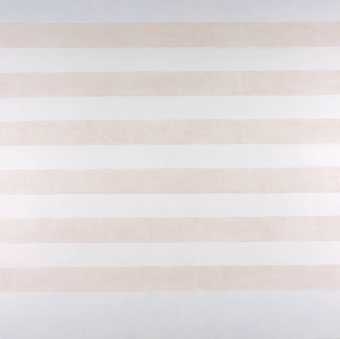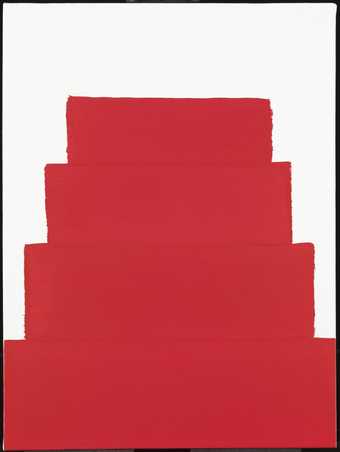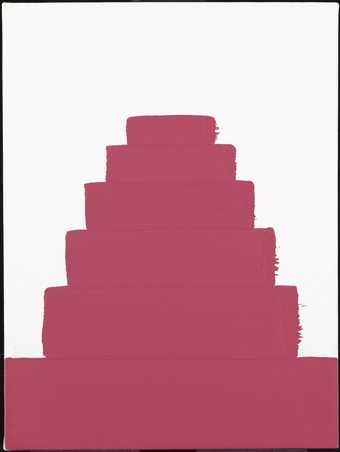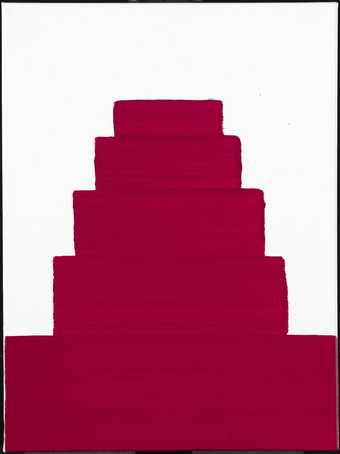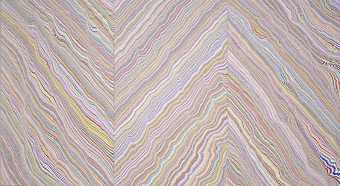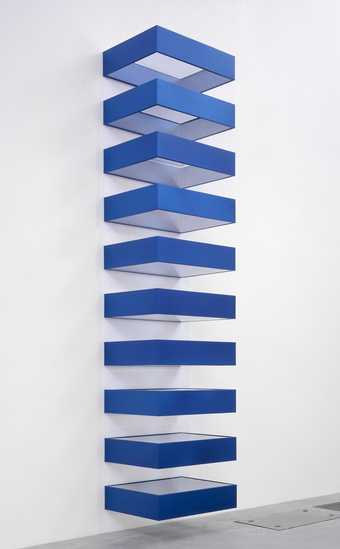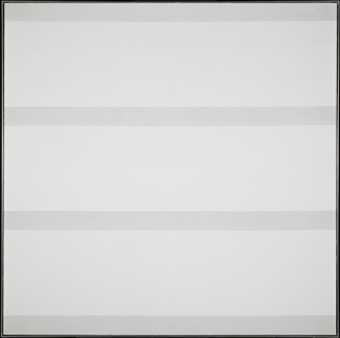
In Tate Modern
In the Studio
Free- Artist
- Agnes Martin 1912–2004
- Medium
- Acrylic paint and graphite on canvas
- Dimensions
- Support: 1525 × 1525 × 35 mm
frame: 1545 × 1545 × 50 mm - Collection
- ARTIST ROOMS Tate and National Galleries of Scotland
- Acquisition
- ARTIST ROOMS Acquired jointly with the National Galleries of Scotland through The d'Offay Donation with assistance from the National Heritage Memorial Fund and the Art Fund 2008
- Reference
- AR00178
Summary
Faraway Love is a five-foot square, blue and white abstract painting on canvas by the Canadian–American artist Agnes Martin, signed and inscribed by the artist on its verso. The square pictorial field is divided into five thin horizontal bands of white background paint and four thick rectangular blocks of overpainted light blue acrylic, all of varying size, divided by wavering graphite pencil lines. As with all works from this period by Martin, Faraway Love was begun by priming the entire surface of the canvas with an opaque coating of white acrylic gesso, which is never fully covered by the subsequent layers of blue. This gives the painting an all-over visual sparseness and vibrant luminosity, the white gesso sealing and emphasising the slightly toothy texture of the linen canvas support. On top of this base coat of paint the artist measured out and marked with pencil the rectangular bands into which she painted the large blue segments, with rough brushstrokes and even some fingerprints visible, using a different type of acrylic, Liquitex, which gives a translucent and light-reflecting finish.
The painting was completed by further reinforcement of the pencil lines demarcating the surface of the canvas, drawn on top of the Liquitex (so that some of the blue escapes underneath the lines), in a reversal of the traditional notion of drawing as preparatory work to be painted over. These strong, persistently irregular horizontal lines are drawn so as not to reach the edge of the canvas, with the small gaps creating the impression that the lines are floating across the pale field. This shuddering, incremental approach to delineation emphasises the centrality of drawing to Martin’s painting. The type of line produced by the artist is not uniformly straight: despite her use of a ruler it exhibits an undeniably hand-drawn quality, tracing the bumps of the canvas surface. On the subject of her lines, Martin has commented: ‘I drew them just as perfectly as I could, I didn’t think at all about my hand, but in nature it is impossible to make a perfect line, so the lines have that lack of perfection. The composition carries it.’ (Quoted in Serpentine Gallery 1993, p.13.) This statement points towards the fundamental principle of Martin’s painterly approach, which reaches for flawlessness in the full knowledge that it is unachievable. One fragmentary note by the artist, published as part of her collected writings in 1991, articulates this concept clearly: ‘I hope I have made it clear that the work is about perfection as we are aware of it in our minds but that the paintings are very far from being perfect – completely removed in fact – even as we ourselves are.’ (Quoted in Schwarz 1991, p.15.)
Faraway Love was produced in Martin’s final studio in Taos, New Mexico, to which she moved in 1994 from the more remote Galisteo. The first series of paintings produced in Taos, including Untitled #5 1994 (Tate AR00177), introduced the five-foot square format and the particular hue of sky blue acrylic seen in Faraway Love to the artist’s practice. The curator Michael Govan has analysed the various themes and undercurrents of Martin’s later work of the 1990s and early 2000s, writing: ‘Merging the classical abstract ideal of Platonic geometry with an empty, egoless Taoist meditation, Martin dematerializes the canvas into a transparent, non-hierarchical field of vision, perhaps suggesting the experience (rather than the image) of the landscape of the Southwest desert.’ (Govan, accessed 2 August 2010.)
Faraway Love was first exhibited in 2000 at PaceWildenstein Gallery in New York, as part of a cycle of paintings with titles that reference states of love and happiness, including another work in ARTIST ROOMS, Happy Holiday 1999 (Tate AR00179). This series reintroduced descriptive, evocative titling to the artist’s work, after the preceding group of untitled paintings, such as Untitled #5 1994 (Tate AR00177), which had similar compositions and colour schema. In her interviews, poetry and writings, the artist has often equated beauty and love with happiness, as an abstract concept not influenced by or reflective of her own personal life: ‘In my best moments I think “Life has passed me by” and I am content.’ (Quoted in Schwarz 1991, p.17.) This sentiment chimes with the title Faraway Love, which suggests something out of reach, perhaps even unattainable, which nevertheless remains a pure state, not tainted by melancholy or longing.
Further reading
Dieter Schwarz (ed.), Agnes Martin: Writings/Schriften, Ostfildern 1991.
Julia Peyton-Jones (ed.), Agnes Martin: Paintings and Drawings 1997–1991, exhibition catalogue, Serpentine Gallery, London 1993.
Michael Govan, ‘Agnes Martin: Introduction’, Dia Art Foundation, http://www.diacenter.org/exhibitios/main/89, accessed 2 August 2010.
Stephanie Straine
August 2010
Does this text contain inaccurate information or language that you feel we should improve or change? We would like to hear from you.
Online caption
After a long period of leaving her works untitled, Agnes Martin adopted an exuberant, even ecstatic tone when titling her later paintings. Here, vertical bands of light-coloured paint have been overpainted with white paint, while light and delicate pencil lines mark the edges of the bands. This contributes to the sense of the sublime that characterises Martin’s work. Both the spirituality and geometric aspects of her paintings draw comparisons with the work of Mondrian as well as the colour field paintings of Barnett Newman and Mark Rothko. All share, to some degree, a quest for ‘spiritual otherness.’
Explore
- abstraction(8,615)
-
- non-representational(6,161)
-
- colour(2,481)
- geometric(3,072)
- monochromatic(722)
- emotions and human qualities(5,345)
- purity(43)
You might like
-
Agnes Martin Untitled #5
1994 -
Agnes Martin Happy Holiday
1999 -
Martin Creed Work No. 1102
2011 -
Martin Creed Work No. 1104
2011 -
Martin Creed Work No. 1105
2011 -
Agnes Martin Morning
1965 -
John McLean Opening
1987 -
Bernard Cohen Out There
1994–5 -
Peter Davies Small Touching Squares Painting
1998 -
Cy Twombly Quattro Stagioni: Estate
1993–5 -
Donald Judd Untitled
1990 -
Bridget Riley Evoë 3
2003 -
Robert Mangold Column Structure II
2006 -
Agnes Martin Untitled #5
1991 -
Cy Twombly Untitled (Bacchus)
2008


